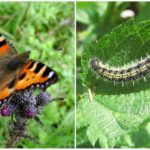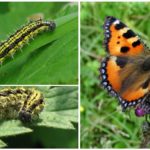Nettle Caterpillars - Black Caterpillars on Nettle
- Urticaria caterpillar
- Urticaria caterpillar
The urticaria caterpillar is one of the most common insects that can be found in central Russia and beyond. She has a fairly wide range of habitat. Also found in Siberia, Small and Central Asia, Japan, China, Mongolia, Korea. Representatives of this species are often found in many CIS countries: Ukraine, Belarus, the Baltics, and Moldova. These are very stable individuals, so they can be found even high in the mountains.
External distinguishing features
The adult butterfly is striking in its beauty.
- It has a bright orange or brick color.
- Each wing has its own unique pattern. It is like a human fingerprint. In nature, there are no two identical patterns.
- The nettle caterpillar has a black or dark color. Along the entire body there are oblong yellow stripes.
- The body also has short villi. In length, it reaches 5 cm.
On a note!
Looking at the photo of the caterpillar of the urticaria, it is easy to confuse it with the caterpillars of the day peacock eye. These two species have many similarities in appearance. In order to reliably determine the identity of an individual, one should pay attention to the plant on which it was found.
Power Features
As food use leaves of stinging nettle, stinging nettle, nettle ordinary. Also in the list of what the caterpillar urticaria feeds on, there are other representatives of the nettle: hops, hemp, and others.
Interesting!
In France, butterflies of this species are called turtles, and in Germany, chanterelles.
Pests are very voracious. This results from the fact that for high-grade pupation and turning into a butterfly they need a lot of energy. A large number of individuals can lead to the death of the plant on which they settled.
Development
The culture that urticaria caterpillars feed on is also their home. Pests live in families, rarely crawl. After pupation time comes, they place their pupae right on the same plants.
There are 2 periods when the urticaria caterpillar appears. The first generation hatch in late spring and early summer. This is May-June.
Important!
In the southern latitudes, during the warm period, 2-3 generations of urticaria caterpillars have time to grow.
The second generation is born in July and August. Adult butterflies go to wintering, hiding in hollows and under the bark of trees. Only fertilized individuals survive the cold. The butterfly may even freeze through, but it will not kill her either. With the onset of heat, she will return to life.
The butterfly caterpillar of the hives is not afraid of stinging nettles and actively takes it up for its place of residence. During the period of maturation, she goes through several stages of molting. After each increases in size. In 30 days it can grow up to 5 cm.The time of transformation from a pupa into an adult is a couple of weeks.
Black caterpillars on the nettle can be found in parks, meadows, near the dachas and private houses. They also often choose the habitat of the valley and the highlands. If the nettle leaf is covered with a large number of black caterpillars, it means that these are urticaria and in 2-3 weeks you can see very beautiful butterflies.









